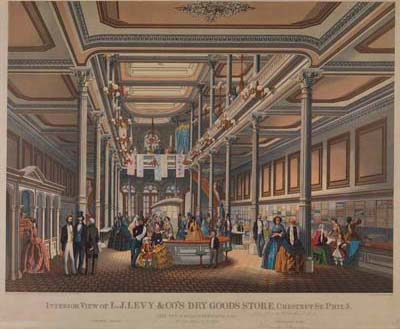ADVERTISEMENTS
Max Rosenthal, Interior View of L. J. Levy & Co.’s Dry Goods Store, Chestnut St. Phila.: Erected in 1857 by W. P. Fetridge, Esqr. 55 Feet Front & 175 Feet Deep. (Philadelphia: Lith. & Printed in Colors by L. N. Rosenthal, ca. 1857). Chromolithograph. Courtesy of the Historical Society of Pennsylvania.
From the 1840s through the 1850s, advertising prints, many with prolific lettering and signage covering the front elevation of a store, became a staple of the larger-format, loose prints issued by Philadelphia lithographers. Given away to the businesses’ distributors, the prints also served as advertisements in streetcars, hotel lobbies, and storefronts. Although usually depicting exteriors, lithographed advertisements occasionally showed interior views as well. The proprietor L. J. Levy apparently felt the artist’s disruption to his business at 809-811 Chestnut Street was worth the potential increase in business. (See Section I).
Click image for larger view.
